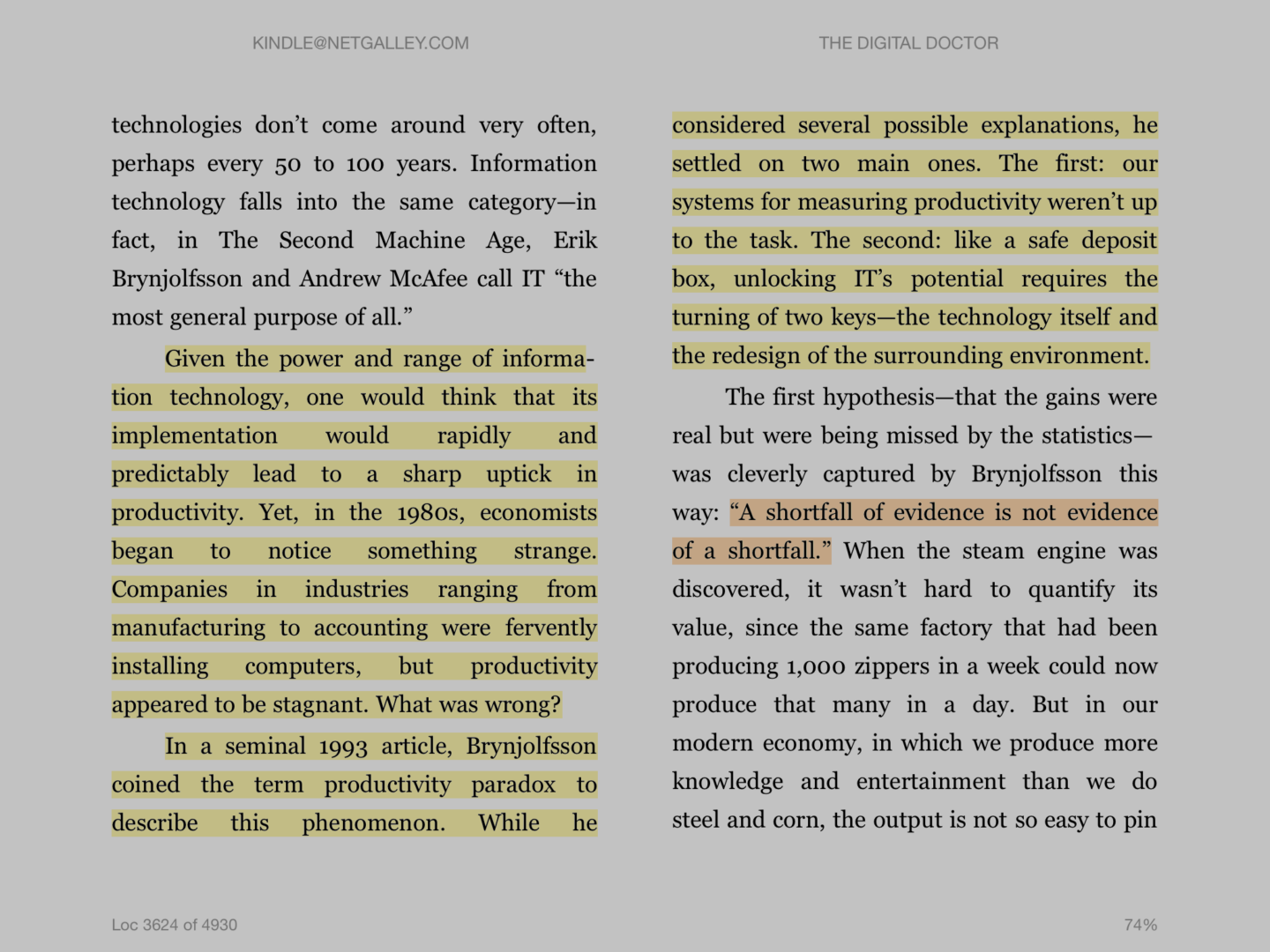I've been reading a preview copy of the upcoming book (due out in April) by Dr. Bob Wachter, The Digital Doctor. It's fantastic and provides a real-world, even-handed take on healthcare IT, including EMR/EHR systems. What's the promise, what works, what potential is unmet, and what fails miserably? It's a great read.
I'll be interviewing Dr. Wachter soon for my podcast series, on patient safety, Lean, and his book. If you have questions for him, let me know.
There's one section that references one of my MIT professors, Erik Brynjolfsson.
He wrote about what's called the “productivity paradox.” With new information technologies, adopters (and observing economists) would expect to see a “sharp uptick in productivity,” but that often doesn't occur. Productivity appears to be stagnant.
Sometimes, the healthcare IT initiatives and the billions of dollars that have been spent… seem to be repeating a similar pattern. EMR/EHR systems aren't necessarily leading to the huge cost savings that were promised. But, would we consider NOT continuing to move forward, working to make these systems better over time rather than giving up?

Brynjolfsson identified two factors that might explain this:
- The productivity measurement systems aren't “up to the task”
- Productivity comes from not just the technology, but from also changing the way you work
So, it could be that IT systems fail to deliver their promise OR we're just not measuring and describing the benefits properly. A cynic would say, “stop defending that failed system” and an IT enthusiast might say, “don't be so closed minded about how you define success.”
Brynjolfsson says:
“A shortfall of evidence is not evidence of a shortfall.”
The Kaizen Paradox?
This got me wondering if there's a “Kaizen Paradox” (or maybe more broadly a “Lean Paradox”). If these approaches are adopted, we'd expect to see big advances in safety, quality, waiting times, cost, etc. (and a better workplace).
Sometimes, an organization can't really point to any benefits of Lean, even after a few years. Is that a measurement problem, an execution problem, or a matter of focusing on the wrong things? Doing lots of training and 5S-ing the nurses stations might not provide any benefit… at least in the short term. Some might say, “we're building new capabilities and developing new ways of thinking.” That's not easily measurable either. But, it has to eventually impact the organization and its measures, right?
But, we often do see great results. Most organizations, including in healthcare, are oriented around measuring cost savings and ROI. Even if you have those results (Franciscan St. Francis has saved millions with Kaizen and our KaiNexus customers have documented almost $50m in savings now), cost savings or bottom-line impact is an incomplete view of the benefits of Kaizen.
Improved patient satisfaction might have some direct reimbursement impact (due to HCAHPS scores and incentives), but it might be hard to measure. What's the “cost savings” from preventing errors, reducing E.D. waiting times, and reducing discharge delays? About half of the improvements documented by our KaiNexus customers affect quality and/or safety, but the definitive results are often hard to measure and they're especially to hard to translate into dollars.
How do we strike the balance between “doing the right things” (engaging staff and improving patient care) with the need to measure and demonstrate results?
Listen to Mark read this post (Learn more and subscribe):
Thanks for reading and for listening!
Please scroll down (or click) to post a comment. Connect with me on LinkedIn.
Let’s build a culture of continuous improvement and psychological safety—together. If you're a leader aiming for lasting change (not just more projects), I help organizations:
- Engage people at all levels in sustainable improvement
- Shift from fear of mistakes to learning from them
- Apply Lean thinking in practical, people-centered ways
Interested in coaching or a keynote talk? Let’s talk.
Join me for a Lean Healthcare Accelerator Trip to Japan! Learn More










As you know, IT systems cannot, in and of themselves, drive productivity. Productivity is tied to process improvement. If your process is bad, and you digitize it, you simply have a bad digital process. Therein is a big part of the problem. Secondly, there are very few ‘fresh and modern’ HealthIT software solutions on the market. Most have been built upon 25 years of monolithic legacy code. Usability is a big problem, which certainly impacts productivity.
On the flip side, it is wonderful to see that doctors and nurses are finally started to get a more complete picture of a person’s health history – that is a huge step forward enabled by HealthIT. Further, HealthIT also brings ever improving decision support, and alerting on things like drug-drug interactions. We don’t measure avoided problems – so we’ll never really tease out the positive impact that this decision support is making, but there are enough anecdotal stories to know that it is material.
Thanks for the comment, Earl. I think you’ll really want to read Dr. Wachter’s book when it’s out. He digs into these issues… such as the usability problems and how healthcare IT often pretty directly harms productivity through bad usability and such.
There are many problems from the manufacturing ERP era that are being repeated in hospitals with EHR systems. Trying to keep workflows consistent with the software (and vendors saying that “best practices” are built into the software), for example.
The systems do seem to measure at least some “avoided problems” if you count each alert and flag that’s given to doctors and nurses. But, due to configuration choices and bad design, the users are bombarded with warning messages, “alarm fatigue” kicks in, and people develop (or are taught) bad habits, such as ignoring and mindlessly clicking through errors. There’s a story in the book about a child being given a 39x overdose of a medication, with poorly designed alerts and alarm fatigue being part of the issue (along with human factors and psychology).
It seems that this beta or 1.0 version of health IT needs to get a lot better. Healthcare’s not going to move away from technology like this, but it needs to better support the people and the processes in our health systems, it seems.
Mark,
Very much looking forward to the book.
HealthIT has a constraint that MFG ERP does not – which is the oppressive regulatory environment. Whether it is the meaningful use regulatory carrot, or the regulatory fines stick – regulation plays a huge role in HealthIT decision making. While smaller ambulatory practices may have decisions driving by the needs of the docs and nurses, for larger systems, my personal observation is that the decisions are overly biased by the need to have a strong defense on the field in the face of regulations, rather than having a strong offense of the field supporting docs and nurses in the battle for better care. I know I’m being a bit hard here, but I do believe if the regulations were not so oppressive, some very different decisions around HealthIT architecture would have been made.
Wachter covers this in the book… the different options that DC had about either 1) setting standards or 2) directly subsidizing Health IT. He points out that radiology needed no such incentives to adopt digital technologies. Manufacturing ERP never had DC throwing $30 billion in direct subsidies to companies, either. There’s a strong argument in the book that EMR/EHR is better at BILLING effectively (or MORE) than it is at fully supporting the quality of care. EMR solves some types of errors, but introduces others. In a way, the government subsidized technology that allows the hospitals to bill Medicare/Medicaid for more money… oops? But it seems the argument is “we had to give this boost to digitization of healthcare, then we’ll sort it out later.”
From a former health system CEO:
Earl is right – applying new or modified technology will not, in and of itself, automatically reduce waste. Unfortunately, many healthcare (and other) organizations, even those who work through process improvement initiatives, stop short of significantly changing untouchable areas like staffing levels, roles and responsibilities. Unions, job titles and descriptions, culture, etc, all contribute. The result, while it may be compliant with regulations, is little if any true reduction in waste with associated savings.
So what is the tipping point or success measure? Is it greater patient flow? More revenue? Improved patient satisfaction scores?
What is the cost of just focusing on the numbers and forgetting or minimizing the importance of the human element? Burn out, decreased job satisfaction, etc.?
I have a hard time using widgets made as the measuring tool when in healthcare we are not making widgets.
I fear managed care that tells me from their laminated approval grid card that $X is the amount they will pay for this service or they will reimburse $Y for that procedure or length of stay.
Imagine trying to reduce the flow of water down the mighty Mississippi to save water and utilize its flow more wisely but expecting businesses to increase capacity and productivity on the now diminished waterway.
Narrower shipping lanes and more traffic with shallower waters can only result in calamity. Yet this seems to be the current and future model for healthcare both in and out of the hospital.
I also worry what this will look down the line if/when systems begin at stratify patients based upon payout.
Will lower incomes and lesser paying reimbursements conditions set up further healthcare access inequalities? Will the person with a cut from a kitchen knife while cooking or accidentally breaking through plate glass suffer greater morbidity or mortality because they get bumped for the higher paying CHF patient?
Great questions. I understand the concerns.
This is where great healthcare organizations and great leaders can’t just go “by the numbers.” What’s the mission, vision, and values… what’s the sense of purpose?
I’m certainly not suggesting that the numbers or ROI are the only important thing with Lean or Kaizen. The challenge is that the existing healthcare world we work in tends to think that way.
Agree with the earlier comments; there are often inflated expectations over what a new technology will, on its own, bring to an organisation. It also doesn’t help when expectations are drummed up by those with vested interests. There is a time and place for technology, it just shouldn’t be a knee-jerk reaction to problems.
Regarding the focus on demonstrating ROI, I remembered how Ohno framed this paradox: “People who can’t understand numbers are useless. The gemba where numbers are not visible is also bad. However, people who only look at the numbers are the worst of all”. To me it suggests that we need to help people to find a balance as either extreme is undesirable. Of course that means coaching people out of their comfort zones, which is easier said than done.
Right, neither extreme: “only ROI” or “never look at ROI” isn’t good. As they say… in all things balance.
Now, a Theory of Constraints person would point out that if you’re not increasing performance at the system constraint (bottleneck) you wouldn’t expect to see any system improvement!
And they would be correct!